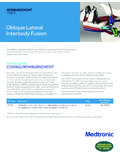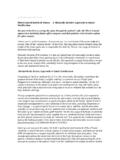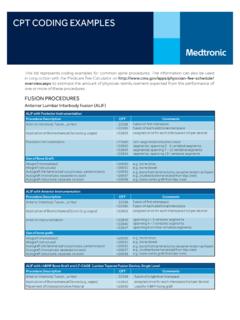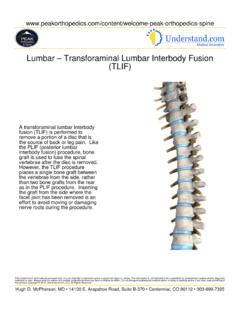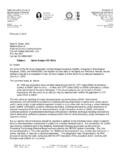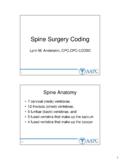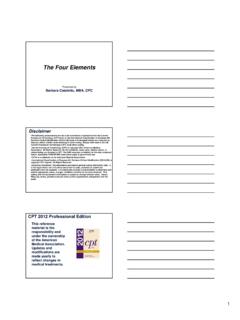Transcription of A Finite Element Study of the Stress Redistribution …
1 2009 Abaqus Taiwan Users Conference 1/12 A Finite Element Study of the Stress Redistribution of the lumbar Spine after posterior lumbar interbody fusion Surgery Hsuan-Teh Hu1, Kuo-Yuan Huang2,3, Che-Jung Liu1, Ching-Sung Kuo1,4 1 Department of Civil Engineering, National Cheng Kung University 2 Institute of Clinical Medicine, College of Medicine, National Cheng Kung University 3 Department of Orthopedics, National Cheng Kung University Hospital 4 Center for General Education, Nan Jeon Institute of Technology ABSTRACT In this Study we focused on the effect of the posterior lumbar interbody fusion (PLIF) surgery on the adjacent discs.
2 By using the Finite Element (FE) method, we investigated separately the responses of bone graft fusion and screw fixed system to various loading modes from different models divided into seven types: intact lumbar , (PLIF,L4-5), (PI,L4-5), (PLIF+PI,L4-5), (PLIF,L3- 5), (PI,L3-5), and (PLIF+PI, L3-5). In addition to approaches to the discrepancy between bone graft fusion and screw fixed system about the Stress changes under separate loading conditions: preload, extension, flexion, lateral bending, and axial rotation, we compared the variation of relative angle of the endplates, changes of the von Mises Stress and strain energy after PLIF surgery.
3 The results showed that the pedicle screw played an important role in raising the maximum von Mises Stress to the adjacent discs: (1)In extension and one-level model, von Mises Stress increment was about 4-8% raised in the adjacent discs, while in two-level model the increment was 11-18% in the upper disc adjacent to the fusion and 6-10% in the lower one. (2)In flexion, the increment was about 3-14% raised in the upper disc in one-level model, but decreased in two-level model with bone graft fusion . (3)In lateral bending, the increment decreased in one-level model in the upper disc but increased about 1-4% in the lower one.
4 In tow-level model the increment was around 2% in the adjacent discs. The numerical results also indicated that bone graft fusion would increase the strain energy percentage of the adjacent discs, and all the models with screw fixed system had higher increment in the adjacent discs than with bone graft fusion . Keywords: posterior lumbar interbody fusion (PLIF), bone graft fusion , screw fixed system, von Mises Stress , strain energy. 1. Introduction The spinal disorders usually occur in the lumbar region because of the wide physical movement and frequent loading caused from the daily activity of the body [1].
5 There were about 80% of adults suffer- ing from the back pain [2] due to the illness of the lumbar spine. Most of them would recover after conservative treatment, but few of them still had to take a surgical treatment due to severe symptoms resulting from the compre- ssion on the nerves. There were many types of surgery for treating different spinal disorders, the lumbar interbody fusion was one of the surgery techniques chosen. The purpose of the lumbar fusion surgery was to fuse two or more segments together after the damaged parts of the lumbar spine were removed.
6 Generally, the screw fixed system would be implanted to maintain strength of the initial stage of the lumbar spine after surgery, and to ensure the bone graft fusion rate higher. However, some accelerated degeneration problems would occur in the adjacent regions of the fused segment after surgery. These accelerated degeneration phenomena were considered to be originating from the segment stiffened by 2009 Abaqus Taiwan Users Conference 2/12 the fusion or screw fixed system.
7 It changed the transmission of Stress , and induced some Stress concentrations in the adjacent parts, but the roles of the bone graft fusion and screw fixed system were still not confirmed. In PLIF surgery the surgeon cut off some lamina or facet joint to excise the damaged part through the low back incision, and then some bone graft or other spacer was put into to fill the space [3]. In recent years, some clinical researches reported that the adjacent parts of fused verte- bra segment would degenerate faster, and the reason was directed to the more stiffened segment of the interbody fusion [4].
8 However, some researches argued that the weakness of the damaged segment could induce more ex- ertion to the adjacent parts before surgery [5]. The purpose of this Study was to figure out the difference between the pedicle screw and bone graft fusion appearing after the PLIF surgery. Although the objective of the PLIF surgery was bone fusion , the screw fixed system influencing the transmission of the Stress could not be ignored in the viewpoint of mechanics. 2. Methods FE Models We constructed the mesh of the lumbar spine model by getting the vertebral bound- aries from the DICOM files scanned by Computed Tomography(CT), and retouched each CT slice to make the boundary line more smooth in 3D-Doctor software, and then stacked each boundary line to form the 3D surface model(STL formatted file).
9 After we imported the STL file into for the preprocessing of the model, a converted input file was exported to ABAQUS for execution and post-processing. The detailed steps adopted in this Study are shown in Table 1. There were seven models corresponding to the specific surgery conditions whose notation is listed in Table 2. The purpose of this setting was to separate the influence of the pedicle screw and the bone graft fusion , we would observe the variations in relative angle of the endplate (the angle between two vertebrae), maximum von Mises Stress and strain energy in the adjacent discs after surgery, because the last two physical quantities were related to the fracture.
10 Materials The spine consists of 33 vertebrae and is generally divided into five regions: cervical, thoracic, lumbar , sacrum, and coccyx, as sh- own in Fig. 1 [6]. Each vertebra (Fig. 2) is composed of cancellous bone, cortical shell, posterior bone, and endplates. A disc, shown in Fig. 3 [7], is composed of nucleus pulposus, annulus fibrosus, and annulus ground substance. This Study adopted linear and isotropic material properties for most spinal components such as the cancellous bone, cortical shell, posterior bone, endplate, annulus ground substance, and nucleus pulposus, whereas spinal ligaments, shown in Fig.
